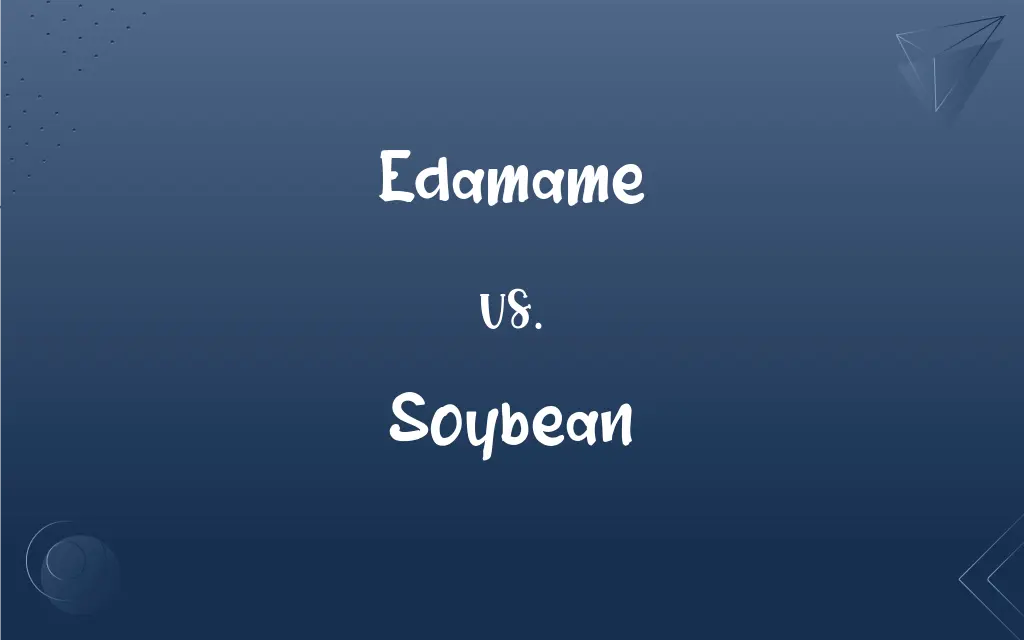Edamame vs. Soybean: What's the Difference?
Edited by Aimie Carlson || By Janet White || Published on February 3, 2024
Edamame are young, green soybeans, often served in pods, while soybeans are mature beans used in various foods and oils.

Key Differences
Edamame is a term for young, green soybeans harvested before they ripen. Soybeans, on the other hand, are fully matured beans, often beige in color. While edamame is harvested when the beans are soft and edible, soybeans are harvested when they harden and dry.
Edamame is commonly served as a steamed or boiled snack, often in their pods, and is popular in East Asian cuisine. Soybeans have a broader range of uses, including the production of soy milk, tofu, soy sauce, and various meat substitutes.
Both edamame and soybeans are rich in protein, but edamame, being younger, has a slightly higher water content and is softer in texture. Soybeans, due to their mature state, are higher in calories and have a denser nutrient composition, including fats.
In many Asian cultures, edamame is a staple appetizer or snack, symbolizing simplicity and health. Soybeans have a more global presence, recognized for their versatility in food industries and for being a major source of vegetable oil and protein.
Edamame is usually sold fresh or frozen, sometimes still in the pod. Soybeans are processed in various forms – whole, split, or ground into flour. They are integral to numerous processed foods and are available in many forms worldwide.
ADVERTISEMENT
Comparison Chart
Stage of Harvest
Young, green beans
Mature, fully-grown beans
Color
Bright green
Beige to light brown
Texture
Soft, moist
Hard, dry
Culinary Use
Eaten as a snack or appetizer
Used in a wide range of products like tofu, soy milk
Nutritional Profile
Lower in calories, higher water content
Higher in calories, rich in fats and proteins
ADVERTISEMENT
Edamame and Soybean Definitions
Edamame
Edamame are immature soybeans, often eaten steamed.
We ordered a bowl of edamame as a healthy appetizer.
Soybean
Soybean plants are cultivated worldwide for various uses.
The versatility of soybeans makes them essential in global agriculture.
Edamame
Edamame pods are a source of protein and fiber.
For my diet, I snack on edamame for its high protein content.
Soybean
Mature soybeans are often dried and processed.
Dried soybeans are ground into flour for baking.
Edamame
Edamame is a popular snack in East Asian cuisine.
At the Japanese restaurant, edamame was served as a complimentary starter.
Soybean
Soybean is a legume used in many food products.
Soybean oil is a common ingredient in salad dressings.
Edamame
Edamame is traditionally served salted and whole.
We enjoyed freshly steamed edamame with a sprinkle of sea salt.
Soybean
Soybeans are a major source of protein and oil.
Farmers cultivate soybeans primarily for their protein-rich beans.
Edamame
Edamame, a young soybean, is harvested green.
The edamame in my garden are ready to be picked while they're still green.
Soybean
Soybeans can be processed into milk, tofu, and flour.
Soybean milk is a popular dairy alternative for vegans.
Edamame
Fresh green soybeans boiled as a vegetable.
Soybean
An annual leguminous plant (Glycine max) native to East Asia, widely cultivated for its seeds, which are used for food, as a source of oil, and as animal feed.
Soybean
A seed of this plant.
Soybean
A legume plant (Glycine max), commonly cultivated for human and animal consumption and as a nitrogen-fixing ground cover.
Soybean
The edible seed of this plant.
Soybean
An Asiatic leguminous herb (Glycine max, formerly Glycine Soja) the seeds of which (also called soy beans) are used in preparing the sauce called soy. Called also soya bean and soya.
Soybean
The seeds of the Glycine max, which produce soybean oil; - called also soya bean.
Soybean
A source of oil; used for forage and soil improvement and as food
Soybean
Erect bushy hairy annual herb having trifoliate leaves and purple to pink flowers; extensively cultivated for food and forage and soil improvement but especially for its nutritious oil-rich seeds; native to Asia
Soybean
Most highly proteinaceous vegetable crop known
FAQs
Can you eat edamame raw?
No, edamame should be cooked (steamed or boiled) before eating.
Is edamame a healthy snack?
Yes, edamame is high in protein, fiber, and various vitamins and minerals.
Are soybeans and edamame the same plant?
Yes, they come from the same plant, but are harvested at different stages of growth.
What is edamame?
Edamame are young, green soybeans typically served in their pods.
What are the health benefits of soybeans?
Soybeans are rich in protein, fiber, and essential nutrients, and may help in lowering cholesterol.
Are soybeans a good source of protein for vegetarians?
Absolutely, soybeans are a key protein source for vegetarians and vegans.
How is soybean used in cooking?
Soybeans are used in a variety of products, including tofu, soy milk, and soy sauce.
Are there different varieties of edamame?
Yes, there are several varieties, differing slightly in size and flavor.
How significant is soybean in global agriculture?
Very significant, as it's a major crop for protein and oil worldwide.
How do you prepare edamame?
Edamame is usually boiled or steamed and often served with salt.
Can soybean help in weight management?
Yes, its high protein content can aid in feeling full longer, assisting in weight control.
Can edamame be included in a low-carb diet?
In moderation, as it contains carbohydrates but also high in protein and fiber.
How should I store edamame?
Fresh edamame should be refrigerated and consumed quickly, while frozen can be stored longer.
Is soybean allergic reaction common?
Soy allergies are relatively common, especially in children, and can range from mild to severe.
Can edamame be used in cooking like soybeans?
Yes, but it's more commonly eaten as a snack or appetizer.
Is edamame available all year round?
Fresh edamame is seasonal, but frozen edamame is available year-round.
Are there genetically modified soybeans?
Yes, there are GMO varieties, mainly to increase yield and pest resistance.
What are the main uses of soybean oil?
Soybean oil is commonly used in cooking, baking, and in the production of margarine and salad dressings.
What are the environmental impacts of soybean farming?
Large-scale soybean farming can lead to deforestation and habitat loss, especially in sensitive regions.
Is edamame suitable for all diets?
Generally, yes, but those with soy allergies should avoid it.
About Author
Written by
Janet WhiteJanet White has been an esteemed writer and blogger for Difference Wiki. Holding a Master's degree in Science and Medical Journalism from the prestigious Boston University, she has consistently demonstrated her expertise and passion for her field. When she's not immersed in her work, Janet relishes her time exercising, delving into a good book, and cherishing moments with friends and family.
Edited by
Aimie CarlsonAimie Carlson, holding a master's degree in English literature, is a fervent English language enthusiast. She lends her writing talents to Difference Wiki, a prominent website that specializes in comparisons, offering readers insightful analyses that both captivate and inform.































































